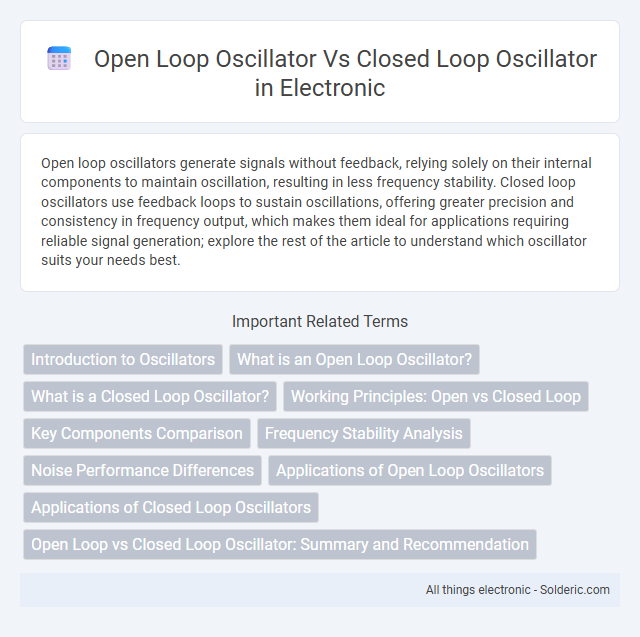Open loop oscillators generate signals without feedback, relying solely on their internal components to maintain oscillation, resulting in less frequency stability. Closed loop oscillators use feedback loops to sustain oscillations, offering greater precision and consistency in frequency output, which makes them ideal for applications requiring reliable signal generation; explore the rest of the article to understand which oscillator suits your needs best.
Comparison Table
| Feature | Open Loop Oscillator | Closed Loop Oscillator |
|---|---|---|
| Feedback | No feedback applied | Uses feedback loop for oscillation |
| Stability | Lower frequency stability | High frequency stability |
| Frequency Control | Frequency depends on component values only | Frequency controlled by feedback network |
| Output Waveform | Less consistent waveform shape | Consistent and stable waveform output |
| Power Consumption | Generally lower power consumption | Higher power due to feedback circuitry |
| Common Applications | Basic signal generation, testing | Communication systems, precise timing |
Introduction to Oscillators
Open loop oscillators generate continuous waveforms without feedback, making them simpler but less stable and precise in frequency control. Closed loop oscillators employ feedback mechanisms to sustain oscillations, resulting in improved frequency stability and signal purity. Understanding the fundamental differences in feedback usage is essential for selecting the right oscillator type in applications like signal generation and communication systems.
What is an Open Loop Oscillator?
An Open Loop Oscillator is a circuit that generates oscillations without feedback, relying solely on an external input or initial conditions to produce a periodic signal. Unlike Closed Loop Oscillators, which use feedback to maintain continuous oscillations, Open Loop Oscillators do not sustain oscillation automatically and often require a triggering mechanism. These oscillators are typically used in applications where controlled, single-cycle oscillations or transient responses are needed rather than steady-state waveforms.
What is a Closed Loop Oscillator?
A closed loop oscillator is an electronic circuit that uses feedback to maintain continuous oscillations by routing a portion of the output signal back to the input. It relies on a feedback loop with a frequency-selective element, such as a resonator or filter, to stabilize the frequency and amplitude of oscillations, ensuring consistent signal generation. Unlike open loop oscillators, closed loop oscillators sustain oscillations without an external input once initiated, making them essential in applications like RF signal generation and clock circuits.
Working Principles: Open vs Closed Loop
Open loop oscillators generate oscillations by amplifying a signal with a positive feedback loop without comparing the output to the input, relying on the intrinsic properties of the circuit components to sustain oscillation. Closed loop oscillators employ a feedback control system where the output signal is continually compared with the input, allowing adjustments to maintain a stable frequency and amplitude. The fundamental difference lies in open loop oscillators operating without correction mechanisms, while closed loop oscillators use feedback to regulate and stabilize the oscillation.
Key Components Comparison
Open loop oscillators rely primarily on an amplifier and a frequency-selective network, such as a crystal or RC circuit, to generate a stable frequency without feedback control. Closed loop oscillators incorporate a feedback loop involving an amplifier and a feedback network that sustains oscillations by feeding a portion of the output signal back to the input. Understanding the key components of these oscillators helps you choose the appropriate design for applications demanding either frequency stability or tunability.
Frequency Stability Analysis
Open loop oscillators typically exhibit lower frequency stability due to the absence of feedback control, making their output frequency highly sensitive to component variations and environmental factors. Closed loop oscillators enhance frequency stability by employing positive feedback that reinforces oscillations at a specific resonant frequency, often stabilized by resonators like quartz crystals or LC circuits. This feedback mechanism minimizes frequency drift and phase noise, resulting in more precise and stable oscillation frequencies critical for communication and timing applications.
Noise Performance Differences
Open loop oscillators generally exhibit poorer noise performance due to the lack of feedback control, resulting in higher phase noise and frequency instability. Closed loop oscillators leverage feedback mechanisms that continuously correct phase and frequency deviations, significantly reducing noise and enhancing signal purity. Your choice between these oscillator types should consider the critical impact of noise performance on application sensitivity and signal integrity.
Applications of Open Loop Oscillators
Open loop oscillators are widely used in signal generation applications such as clock generation in digital circuits, RF signal synthesis, and test equipment calibration due to their simplicity and frequency stability. These oscillators do not rely on feedback to maintain oscillations, making them ideal for producing fixed frequencies in voltage-controlled oscillators and phase-locked loops. Your designs benefit from open loop oscillators when consistent frequency output without complex feedback control is essential.
Applications of Closed Loop Oscillators
Closed loop oscillators are widely used in communication systems, signal processing, and frequency synthesis due to their stability and precision. Your devices benefit from closed loop designs in applications like phase-locked loops (PLLs), voltage-controlled oscillators (VCOs), and radar systems where feedback ensures consistent oscillation frequency. These oscillators provide enhanced noise immunity and frequency control, making them ideal for modern electronic circuits requiring high accuracy.
Open Loop vs Closed Loop Oscillator: Summary and Recommendation
Open loop oscillators generate signals without feedback, resulting in simpler designs but lower stability and precision, making them suitable for low-cost, less critical applications. Closed loop oscillators use feedback to maintain consistent frequency and amplitude, offering higher accuracy and stability for applications like communication systems and signal processing. Your choice depends on performance requirements; choose open loop for simplicity and cost-effectiveness or closed loop for precision and reliability.
Open loop oscillator vs Closed loop oscillator Infographic

 solderic.com
solderic.com